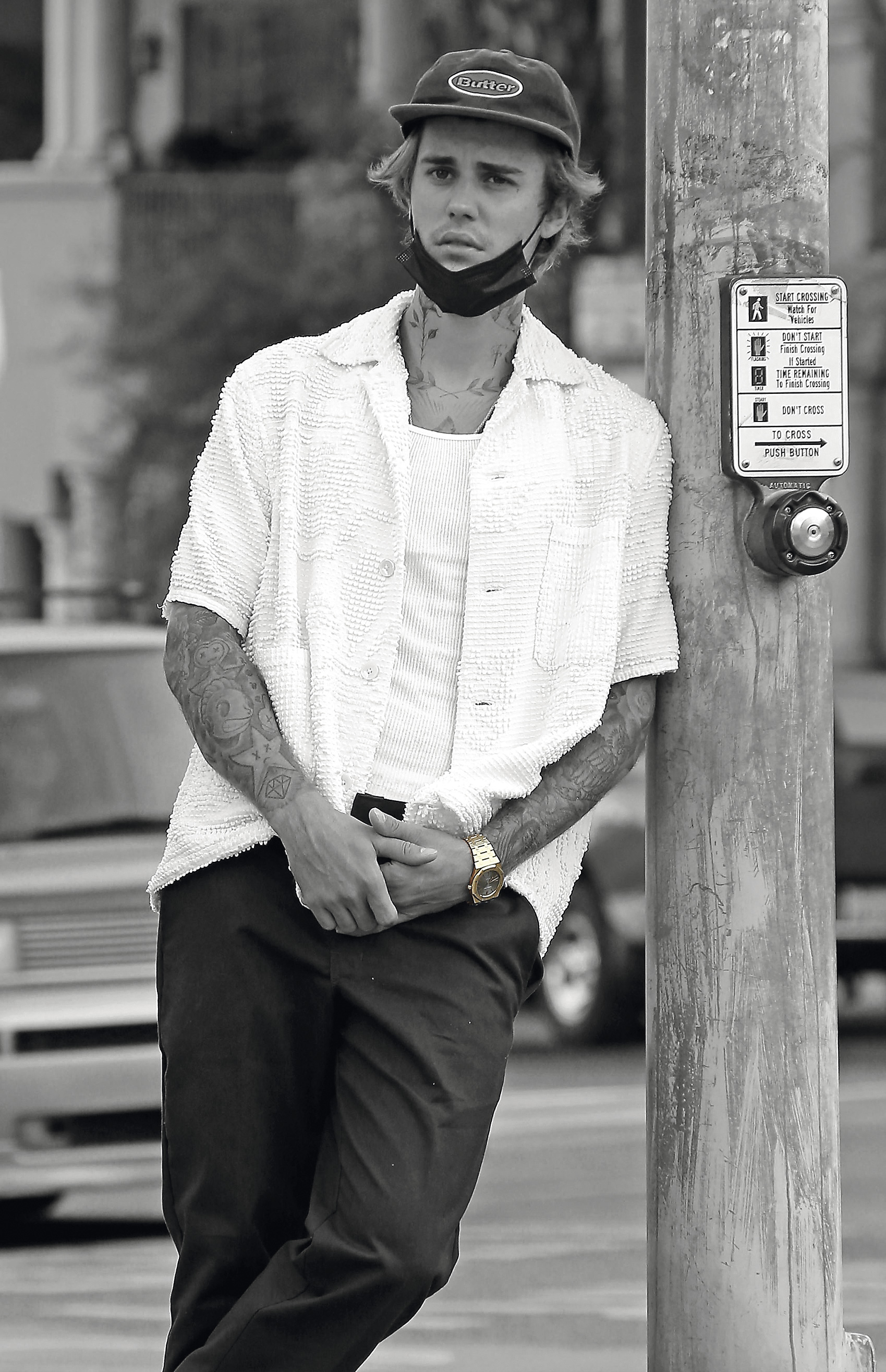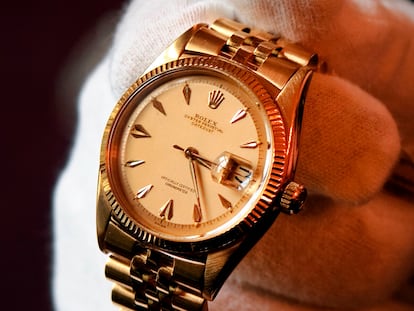Waitlists for $30,000 watches: The fever that’s changing the rules of luxury
Demand for Swiss watches has reached an all-time high. A handful of classic models are leading sales and auction rankings, amid shortages and the rise of unauthorized markets

Felipe likes watches. He doesn’t consider himself to be a collector, but for some time now, he’s been looking for a specific model to give to a family member as a gift: it’s a sports watch with an unmistakable two-tone bezel, which was launched several years ago and continues to be a bestseller.
The watch is a popular model – it’s been a steady presence in its brand’s catalog. The official price (keeping in mind that the amount increases every year) is around 11,000 euros, or $12,000. However, in recent days, whenever Felipe approaches an authorized distributor of the brand in Madrid or other cities in Spain, he gets a similar response: the watch does exist and can be purchased… but it’s not an easy process. “In all the jewelry stores,” Felipe sighs, “they have the same issue: none of them had a date for the next shipment, nor do they know how many units they’re going to receive.”
If Felipe was impatient, he’d probably turn to websites such as Chrono24, where the watch model – second-hand or unused – is available. This is part of the so-called “gray market,” where the buying and selling of watches doesn’t occur through official, authorized channels, but rather through second-hand stores, at auctions, or between individuals. In this market, the price can be double the official one… and the process of getting what you want is as complicated as buying shares on the stock market.
The model Felipe is looking for is currently available on the gray market for an average price of 17,400 euros, or $18,500. But, in March of last year – at the peak of the price curve – it sold for more than $25,000. This is demonstrated by the graphs that Chrono24 publishes, so that potential buyers can find out the value of the best-known models. For example, the Patek Philippe Nautilus – with a 40 mm steel case and blue dial – usually has an official price of around 32,000 euros… but getting one is so difficult that its average price on Chrono24 is around 130,000 euros, or $138,000. In February of 2022, it reached almost $235,000. The Royal Oak automatic – with a 41 mm steel case and an Audemars Piguet emblem – which starts at around 20,000 euros is sold on the gray market today for 34,000 euros, or $36,000. But it used to go for nearly $60,000.
What was once a luxury item reserved for connoisseurs has now made the leap into mainstream culture. Jay-Z and Ed Sheeran have copies of the limited edition of the Nautilus, which the Patek Philippe brand launched in collaboration with Tiffany & Co. Its official price was just over $50,000… but to get one on the gray market today, you have to be willing to spend at least $2.5 million. Of course, this is a very extreme case, as only 170 units of the watch were distributed. Yet, it also illustrates the furor in the world of watchmaking. More than ever, demand is exceeding the amount of exclusive goods that are available.
Patek Philippe Nautilus

Desired like few things in this world – something aggravated by Patek Philippe's adamant refusal to increase its production in line with demand – this sporty, but elegantly proportioned model has changed very little since Gérald Genta designed it in 1976. The rapper Jay-Z has not just one, but many.
The luxury watch business is experiencing a golden moment. According to the latest annual report prepared by Morgan Stanley in collaboration with the specialized consultancy LuxeConsult, exports of Swiss watches, once again, broke records in 2022, reaching 23 billion Swiss francs – or about $25 billion. This is an all-time high. Meanwhile, Swatch – the world’s leading watch company, alongside Omega and Longines – increased its profits by 55% in the first half of 2023. Phenomena such as Moonswatch or Swatch’s new collaboration with Blancpain have accelerated growth. But, as we saw in the latest edition of the Watches and Wonders fair in Geneva, the most thriving sector is the luxury one.
In this niche market – where five brands account for more than 50% of global sales – the top positions remain stable. They are occupied by Rolex – a brand that holds 29.3% of the market, far ahead of its competitors – Cartier, Omega, Audemars Piguet, Patek Philippe and Richard Mille. Even at Hermès – whose main activity isn’t even watchmaking – watch sales grew by 40% last year, thanks to its investment in mechanical watchmaking and highly-complex features.
In addition to the growing visibility of watch brands among the general public – now at the level of fashion brands – the increase in demand is also due to the emergence of new audiences in Asian and Arab countries, which are leading the sales of luxury clothing brands and contemporary art. Another important factor is the consolidation of watches as a means of parking cash in times of economic uncertainty, just like jewelry or real estate. And, in an era marked by rapid consumption and online purchasing, few brands can satisfy the pace of demand, given that many luxury watch-manufacturing processes are manual and highly-specialized. It’s difficult to scale the production of luxury watches, just as it’s hardly possible to outsource it, given that secrecy dominates the sector and components come from suppliers who impose strict limits on what they make. It’s also not easy to find qualified labor – in fact, many brands have established their own watchmaking schools.
Still, the shortage doesn’t affect all brands or all models. Anyone can visit a watch store and find watches at all price points. However, the noise surrounding certain cult models has given rise to unprecedented anxiety among a handful of wealthy consumers. According to a study published by Deloitte in October of 2022, the second-hand watch market is growing and could reach $37 billion in 2023 (as of September, the total is around $21 billion). “This growth is based on the launch of new products, the expansion of existing channels and the fact that consumers are looking for watches that are no longer produced,” the consultancy explains. On the gray market, you can find timepieces that are straight from the store, as well as all kinds of vintage models that their owners have put up for sale after years of use. “There are people who wait three years to receive a watch in-store. Then, they bring it directly [to us] to sell it, in the box, unused, with the documentation and warranty stamped just three days earlier,” explain the experts at Circa, an American company that’s dedicated to appraising and acquiring watches and jewelry.
Rolex Daytona

It was in 1965 when the word “Daytona” – from the American circuit – was added to the dial of the Rolex Cosmograph, a watch designed specifically for motorists. Paul Newman was its most famous user: one of his Daytonas – dedicated by Joanne Woodward – was auctioned off in 2017 for $17 million. In 2023, two others were sold for $2 million.
Experts agree that the gray market has an advantage over authorized distributors: it’s only governed by money, not by waiting lists or circles of trust that are sometimes excessively secretive. “A person who can afford a $50 million boat might not have access to a steel Nautilus in a store,” Circa points out. “Very few units are made and – if you don’t have contacts – auctions or the gray market may be the only opportunities.” But this sector has its own rules. The value of a watch can vary depending on how well-preserved it is, or it can decrease drastically if it doesn’t have all the original parts. “Repairing isn’t the same as restoring,” the experts at Circa clarify. “When someone takes a watch to the brand’s technical service for a fix, they may replace some parts with legal and perfectly authentic service parts… but if [the new parts] aren’t identical to the originals, they can reduce [the watch’s] value,” they explain.
At Circa, potential sellers are taken to private rooms, where experts analyze the watches and compare them to available documentation, which comprehensively identifies the features of thousands of watches. In Spain, for example, when Circa decides to buy a watch, they first keep it for a while, waiting for the police to verify that it doesn’t appear on the list of stolen watches. If everything is in order, they then send the timepieces to the United States, where they are sold or auctioned. About 1,000 watches a year pass through Circa’s offices in Spain, with just over half being purchased. The reason? Many of the watches don’t pass verification checks. “Sometimes, they’re clones that have some authentic components,” the appraisers explain. Clones are detected by comparing the serial, case and movement numbers; others, due to errors in the warranty documents, or because certain details reveal finishes that are incompatible with the standards of quality brands. “Detecting the authenticity of a watch isn’t always easy,” they warn.
However, the ability to certify the authenticity of watches has become crucial in a market that has exploded in recent years. At Circa, they agree that the spring season of 2022 marked a peak moment in prices, which coincided with the rise and fall of cryptocurrencies. “There’s a new type of buyer who [buys watches as an] investment: he’s a speculator, the same type of buyer who acquired cryptocurrencies,” they explain. “The fall of cryptocurrencies and watch prices on the gray market have gone hand-in-hand for a year. There was a lot of demand and the stores ran out of stock, so people started buying watches on the gray market with cryptocurrencies. Now, demand has gone down and prices have recorrected themselves.”
Audemars Piguet Royal Oak

Created in 1972 by Gérald Genta, this is the watch that renewed the masculine status symbol par excellence: it was a piece of steel (not gold), sporty and with angular lines (not round and dressy) and, of course, mechanical (at the beginning of the quartz revolution). Today, it’s no longer just a treasure for connoisseurs: celebrities – such as Justin Bieber, who bought a gold version as a wedding gift – adore it.
This phenomenon, the experts at Circa explain, isn’t applicable to all luxury watches. There are several hundred Swiss brands, but only a few models are in excessive demand. Some examples are the Daytona and the Submariner from Rolex, the Royal Oak from Audemars Piguet and the Nautilus from Patek Philippe. The latter two have a case signed by Gérald Genta – the superstar of watch design in the 1960s – who also signed icons such as the IWC Ingenieur. These are robust watches with a sporty feel: they revolutionized the market with steel cases, metal bracelets and technical functions at a time when few men conceived of wearing anything other than a dress watch on a daily basis. Today, these models remain timeless.
“The Daytona generates stability, it’s like gold,” they comment at Circa. In 2017, the Rolex Cosmograph Daytona ref. 6239 worn by Paul Newman was auctioned off for more than $17 million… a figure so high that it broke the record for the most expensive wristwatch in the world. Aurel Bacs – the Phillips auctioneer who wielded the hammer – acknowledged this past April in an interview with Le Temps that it was impossible to predict this amount. “It’s a market governed not by a need, but by a desire… there’s a strong emotional component,” he stated. Hence, a good part of those $17 million were explained by the mythical status of its previous owner, since the same model of watch – produced at the same time and in the same state of conservation – is worth around $200,000 today.
In any case, exceptions aside, auctions of classic watches have experienced an upward curve across the board. “I was perfectly capable of selling the same watch for 10,000 francs in 1995, for 20,000 in 2000, for 50,000 in 2005, for 100,000 in 2010, for 500,000 in 2015 and for one million [euros] in 2020,” Bacs told the French newspaper.
Vintage collecting is a market less subject to fluctuations. Carlos Ortiz Trilla – a watch enthusiast with 12 years of experience in the sector – has launched his own business, Peluco, focused on historical models defined by their “origin, quality and rarity.”
“The main difference between the gray market and our project,” he notes, “is that the former is a short-term and speculative market, where the resale price of a modern watch is higher than [what’s established] by the manufacturer itself. We have a different vision… one in which [emotional factors are taken into account]. It’s not purely transactional.”
Ortiz Trilla emphasizes that – beyond Rolex and Patek Philippe – recent times have seen a revived interest in Cartier. “[Cartier watches] have always had a strong international following and the auction history is good proof of this, but they were reserved for a few merchants and collectors who valued them. Now, the general public is beginning to realize the potential [of Cartier] and what the [brand] has meant to the world of watchmaking.” The founder of Peluco mentions emblematic models – such as the Tank Normale or the Cintrée – but also rarities, such as the Crash or the Pebble, from the Cartier London division. “They’re watches with a deeply-ingrained esthetic that transcends the barriers of watchmaking.”
Given the rise of the speculative market, some firms in the sector have taken steps to address this. For instance, at the end of 2022, Rolex – which is working on a new factory to increase production – announced the creation of a Certified Pre-Owned project, which puts authenticated Rolex watches on sale, with a two-year warranty, in its authorized distributors. This decision – which other firms are considering – has the stated objective of guaranteeing the authenticity of the models and avoiding fraud… but it could also be interpreted as a way to burst the gray market bubble.
On the other hand, the specialist firm Bucherer has joined forces with Sotheby’s to strengthen its online watch auction department. Faced with the uncertainty that digital sales between individuals causes in many buyers (as the information isn’t always clear and the possibilities of fraud are always present), purchasing and appraisal companies are redoubling their controls. In this business, no one wants to be disappointed if their model isn’t as authentic as they thought, or if their collection isn’t growing in value. “There are watch owners who – when they want to sell their collections – are disappointed to find that the current value isn’t what they expected,” the experts at Circa point out. The laws of the market and the laws of desire don’t always coincide. But, for now, as he wanders around the luxury watch stores in Madrid looking for the perfect gift, Felipe isn’t giving up.
Sign up for our weekly newsletter to get more English-language news coverage from EL PAÍS USA Edition
Tu suscripción se está usando en otro dispositivo
¿Quieres añadir otro usuario a tu suscripción?
Si continúas leyendo en este dispositivo, no se podrá leer en el otro.
FlechaTu suscripción se está usando en otro dispositivo y solo puedes acceder a EL PAÍS desde un dispositivo a la vez.
Si quieres compartir tu cuenta, cambia tu suscripción a la modalidad Premium, así podrás añadir otro usuario. Cada uno accederá con su propia cuenta de email, lo que os permitirá personalizar vuestra experiencia en EL PAÍS.
¿Tienes una suscripción de empresa? Accede aquí para contratar más cuentas.
En el caso de no saber quién está usando tu cuenta, te recomendamos cambiar tu contraseña aquí.
Si decides continuar compartiendo tu cuenta, este mensaje se mostrará en tu dispositivo y en el de la otra persona que está usando tu cuenta de forma indefinida, afectando a tu experiencia de lectura. Puedes consultar aquí los términos y condiciones de la suscripción digital.
More information
Archived In
Últimas noticias
Most viewed
- Sinaloa Cartel war is taking its toll on Los Chapitos
- Reinhard Genzel, Nobel laureate in physics: ‘One-minute videos will never give you the truth’
- Oona Chaplin: ‘I told James Cameron that I was living in a treehouse and starting a permaculture project with a friend’
- Why the price of coffee has skyrocketed: from Brazilian plantations to specialty coffee houses
- David King, chemist: ‘There are scientists studying how to cool the planet; nobody should stop these experiments from happening’











































